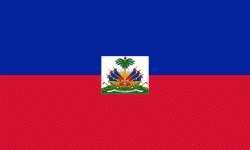Croix-des-Bouquets
Croix-des-Bouquets was founded in 1749 by Royal Decree. Legend has it that the city takes its name from a tradition that had the Spaniards passing to deposit bouquets of flowers at the foot of a large cross that was on the land where the city was built. Croix des Bouquets pursues a tradition of beauty through the sculpture of iron, and the village of Noailles is at the heart of this tradition specifically in ode to Haitian artist and sculptor Georges Liautaud.
On March 22, 1792, the city was the scene of one of the first battles of the Haitian Revolution. Men of color, under the leadership of Pinchinat, Beauvais, and Lambert, took up arms in 1700 in fighting for their political and civil rights.
On September 1791, after the Battle of Pernier, the royalist in La Croix-des-Bouquets made a concordat with the freedmen encamped at Trou-Caïman, which obliged the contractors to execute the national decrees in favor of the freedmen. On September 11, the freedmen came to camp at la Croix-des-Bouquets who signed a concordat with the freedmen in a church in the borough. On October 10, a deputation of the colonists of la Croix-des-Bouquets, sent by Hanus De Jumécourt, came to Port-Républicain, demanding the execution of this concordat.
In 1791, Halaou, the leader of African bands, rebels of the Cul-de-Sac Plain, was killed at Croix-des-Bouquets on February 9. There was a massacre of his group by the soldiers of the western region who occupied the village. Men of color entrenched themselves in the church. General Louis-Jacques Beauvais continued to occupy Croix-des-Bouquets until June, when the English came to remove Port-Républicain. They then returned to Jacmel. The English occupied the city, and returned the people to slavery.
In March 1793, Louis-Jacques Beauvais abandoned Croix-des-Bouquets and went to retreat at Gressier with 500 men. In April 1796, Toussaint L'Ouverture wanting to rid Croix-des-Bouquets of the occupying English, had unsuccessfully attack the outposts of the town. His cavalry reconquered four squadrons of hussars commanded by the Count of Manoux. The English, after several charges, overthrew the republicans, and drove them back to Grands-Bois.
After the occupation of Port-Républicain by the troops of General Charles LeClerc's expedition, General Jean Boudet learned, on February 9, 1802, of the appearance of Dessalines in the Cul-de-Sac Plain. There were immediately 2,000 men occupying Croix-des-Bouquets. On September 19, 1803, Jean-Jacques Dessalines took possession of Croix-des-Bouquets. The first citizen who represented this commune in the first Chamber of Communes in 1817 was Plomba Ladouceur.
On January 11, 1859 President Fabre Geffrard's troops made their entry into resistance. During the Cacos Revolution in 1869, atrocities were committed in the name of President Sylvain Salnave. On January 15, 1870, Generals Saint-Lucien Emmanuel, Alfred Delva, Errié, Ulysses Obas and Pierre-Paul Saint-Jean, after being outlawed by decree, were arrested and executed at Croix-des-Bouquets. The Nordists seized Croix-des-Bouquets on June 28, 1889, after the evacuation of the village by General Canal Jeune, whose forces were insufficient.
Prior to the 2010 earthquake, the once crowded city had been restored. The streets had been cleaned up, wholesale merchants and other commerce had been relocated to Port-au-Prince. Retail commerce which once crowded sidewalks downtown now had a dedicated building. Also, the Cuban medical mission set up a field hospital in the region.
On 25 February 2021, hundreds of prisoners escaped from the Croix-des-Bouquets prison.
Map - Croix-des-Bouquets
Map
Country - Haiti
 |
 |
| Flag of Haiti | |
The island was originally inhabited by the indigenous Taíno people, who originated in South America. The first Europeans arrived on 5 December 1492 during the first voyage of Christopher Columbus, who initially believed he had found India or China. Columbus subsequently founded the first European settlement in the Americas, La Navidad, on what is now the northeastern coast of Haiti. The island was claimed by Spain and named La Española, forming part of the Spanish Empire until the early 17th century. However, competing claims and settlements by the French led to the western portion of the island being ceded to France in 1697, which was subsequently named Saint-Domingue. French colonists established lucrative sugarcane plantations, worked by vast numbers of slaves brought from Africa, which made the colony one of the richest in the world.
Currency / Language
| ISO | Currency | Symbol | Significant figures |
|---|---|---|---|
| HTG | Haitian gourde | G | 2 |
| USD | United States dollar | $ | 2 |
| ISO | Language |
|---|---|
| FR | French language |
| HT | Haitian Creole language |















